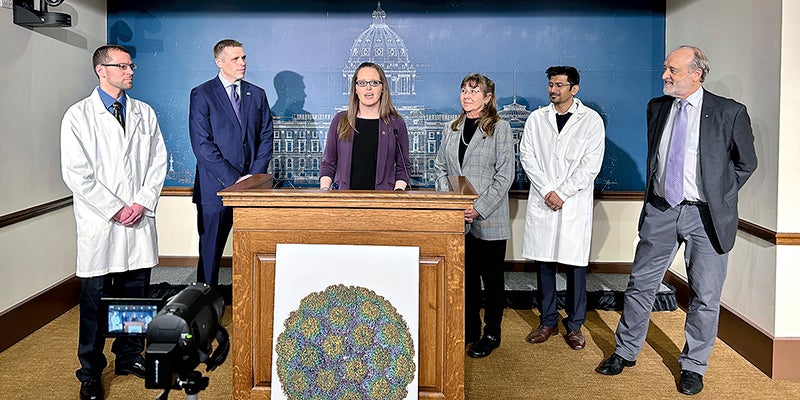Austin, Institute and state leaders advocate for Minnesota Bioimaging Center
Published 6:26 pm Tuesday, April 2, 2024

- Dr. Kyle Messina, The Hormel Institute; Austin Port Authority President Jason Baskin; Representative Patricia Mueller; Dr. Susan Hafenstein, The Hormel Institute; Sayan Das, The Hormel Institute; Dr. Robert Clarke, The Hormel Institute were part of a press conference at the Capitol Tuesday to advocate for the Institute’s MBiC project. Photo provided
|
Getting your Trinity Audio player ready...
|
Austin Port Authority, Minnesota state legislators, and officials from The Hormel Institute held a press conference Tuesday afternoon at the Minnesota State Capitol to advocate for the inclusion of Minnesota Bioimaging Center (MBiC) in the state’s 2024 bonding bill.
In a press release following the event Tuesday, it was explained that the project will expand Institute’s current bioimaging capabilities and provide STEM education and workforce training opportunities to accelerate scientific discoveries in Minnesota that will have lasting, far-reaching impacts.
A piece of equipment that will be installed in August as part of the MBiC project will expand the research facility’s capabilities to include tomography (cryoET) and will also be the first of its kind in North America.
“At MBiC, new equipment that is proven technology will be installed so that we can use this equipment for cutting-edge experiments that will … allow us to look into patient tissues, infected cells, and solve the high-resolution structures of disease-causing organisms,” said Dr. Susan Hafenstein, CryoEM Director and Professor at The Hormel Institute. “This is for the first time. We are bringing this technology to Minnesota … [The equipment is] truly transformational.”
In 2016, Institute was the seventh in the United States to obtain a Titan Krios Cryo Electron microscope (cryoEM), the Nobel-prize winning technology that helps advance the understanding of cancer, Alzheimer’s disease, coronavirus and other viruses, prion diseases like chronic wasting disease and more.
This equipment has also resulted in the emergence of a global need to develop a workforce capable of operating it.
“Not only can scientists do what we were not able to do before, see things in order to find cures that we’ve never been able to see before, but the technology itself has outgrown the workforce. … We find ourselves in a position where we now have to train people at all levels, and we are prepared to do that with MBiC,” Hafenstein said.
Institute Executive Director Dr. Robert Clarke explained that the Institute regularly collaborates with the University of Minnesota and Mayo Clinic on research projects that make use of The Hormel Institute’s advanced bioimaging capabilities, and the expertise needed for MBiC is already at The Hormel Institute, making it the ideal location for the project.
“[The MBiC project is] infrastructure, workforce development, research, STEM education — all of those, statewide, putting Minnesota and Minnesotans at the forefront of what’s happening in research in the United States,” Clarke said. “What we discover has implications for everyone. When you cure a disease in Minnesota, you cure a disease for the world.”
The Institute is requesting $20 million in funding to be allocated for the project from the state’s 2024 bonding bill.
“We want to focus on the true meaning of what bonding is, which is our infrastructure, and then implications that are going to not only affect our state, but also us as a nation,” said Rep. Patricia Mueller. “This type of project, this type of funding … that we’re talking about here is going to not only make us world leaders, but it’s going to be able to bring about medical advancements and medical research that is state of the art, that’s something that we will really be able to hang our hat on here in Austin, Minnesota.”
The MBiC project will also offer innovative STEM education programs for Minnesota students as well as workforce training and education programs to create a pipeline of Minnesota-trained innovators to help meet the worldwide workforce needs that have emerged for this cutting-edge field.
“[This isn’t] just an Austin project. This is with Mayo Clinic, University of Minnesota, and this is going to impact the state, the nation, and the world, because they are leading in cancer research and treatment,” said Sen. Gene Dornink.
The consensus during Tuesday’s press conference was that now is the time to move forward with such a project.
“We need to move as quickly as we possibly can. These technologies move quickly. We’re at the forefront. We need to stay there,” Clarke said. “We don’t want to take a step back, and then try and play catch-up. We want to [stay] where we are and keep pushing forward.”
“We are proud to serve as the fiscal agent and host for this incredible project,” Austin Port Authority President Jason Baskin agreed. “We are in a race … when you think about the impact that [cancer] has on not only … individuals, but their families and loved ones, their friends, and the communities around us, you realize that we have to run even faster to find cures for cancer to save lives across the state, and ultimately, the country. That’s exactly what this project does: the Minnesota Bioimaging Center helps us to run faster by accelerating research, and ultimately cures. This is a transformational project with statewide impact.”





